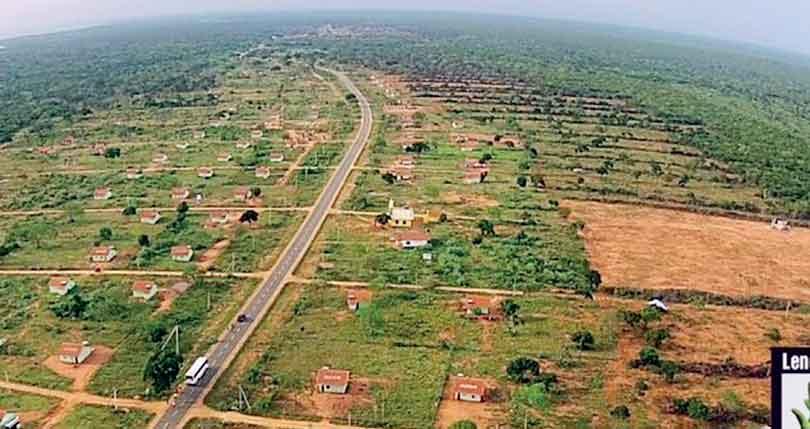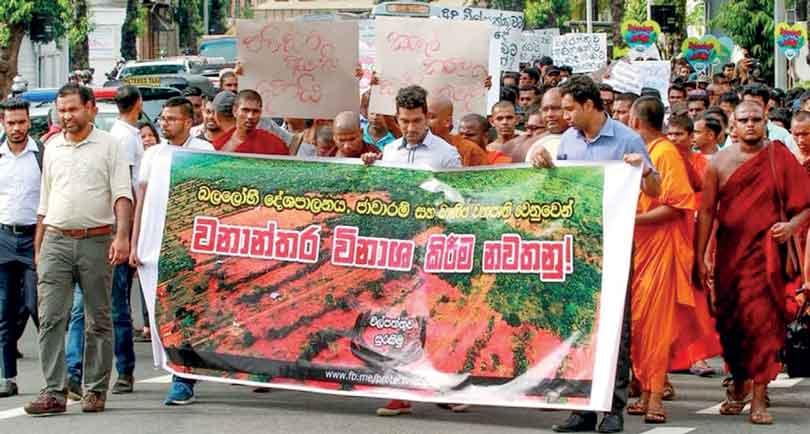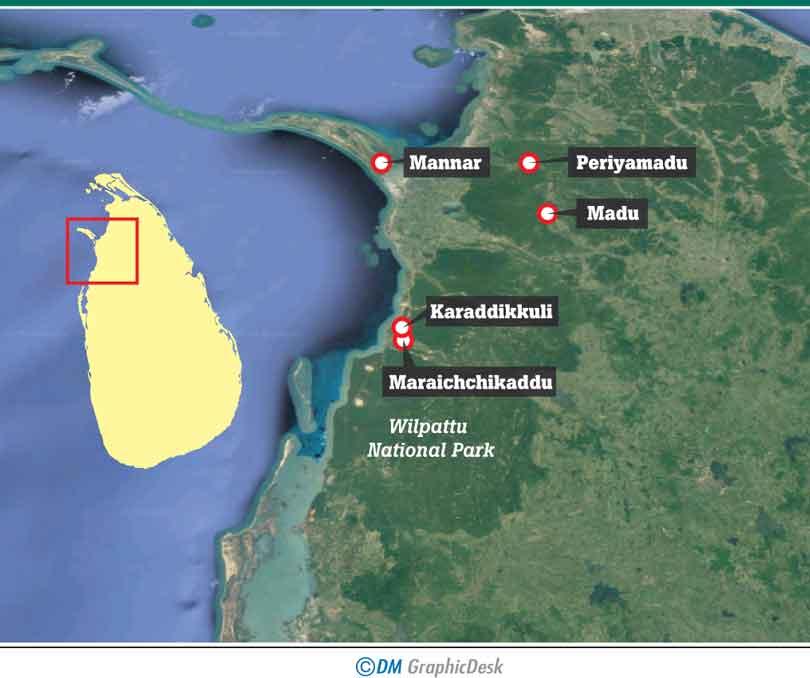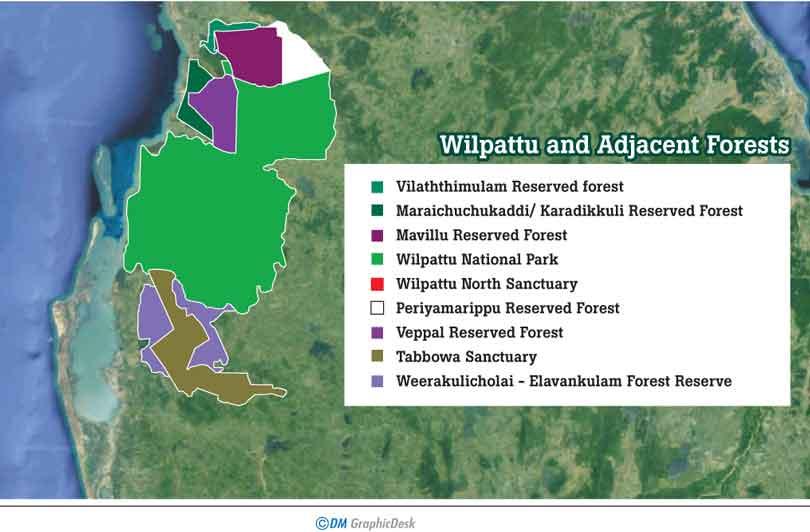Reply To:
Name - Reply Comment

A deforested area in Kallaru Forest Reserve 
Protests that were held against the forest clearance at Wilpattu
 The ‘laws of nature’ emerged victorious last week. This was following a landmark judgment issued regarding the mass scale deforestation activities that took place at the Northern Sanctuary of Wilpattu National Park. Therefore, Reserve Forests including Maraichchukaddi/ Karaddikuli Reserve Forests standing westward of Wilpattu blocks II and IV and forest areas in Madu, Periyamadu and Mannar fell prey to political agendas. What transpired was an illegal resettlement programme in the guise of reconciliation. Although resettlement couldn’t have happened overnight, deforestation certainly did. However, after five long years of protesting, court hearings, discussions and debates, the Court of Appeal not only ruled that there had been a violation of the law, but also ordered former Minister Rishad Bathiudeen, one of the respondents, to pay for the damage keeping with the Polluter Pays Principle.
The ‘laws of nature’ emerged victorious last week. This was following a landmark judgment issued regarding the mass scale deforestation activities that took place at the Northern Sanctuary of Wilpattu National Park. Therefore, Reserve Forests including Maraichchukaddi/ Karaddikuli Reserve Forests standing westward of Wilpattu blocks II and IV and forest areas in Madu, Periyamadu and Mannar fell prey to political agendas. What transpired was an illegal resettlement programme in the guise of reconciliation. Although resettlement couldn’t have happened overnight, deforestation certainly did. However, after five long years of protesting, court hearings, discussions and debates, the Court of Appeal not only ruled that there had been a violation of the law, but also ordered former Minister Rishad Bathiudeen, one of the respondents, to pay for the damage keeping with the Polluter Pays Principle.
Laws violated
Since 2009, the upper area of Wilpattu was being cleared to settle people who were said to have been displaced due to the war. In 2012 there were more clearances amidst strong protests. By 2014 clearances were also taking place in areas such as Madhu, Periyamadu and Mannar. However, since 2012 most of these forests have been gazetted by the Forest Conservation Department (DFC) as Reserve Forests.
According to Hemantha Withanage, Executive Director at Centre for Environmental Justice, once gazetted, an Environmental Impact Assessment is required if more than one hectare of land is cleared in a Forest Reserve. On the other hand if a forest area is gazetted, no party can utilise it for any other purpose until that gazette is cancelled or revoked. If the land had to be released it is the Minister that has the power to release the land as per section 4(2) of the Forest Conservation Ordinance.
The judgment is way better than a fine of Rs. 10,000-100,000 or a jail term of two to five years
Hemantha Withanage
Therefore the CEJ filed a Writ petition (C.A (Writ) 291/2015) and named DFC as the first respondent to the case on grounds that it had violated the law. On the other hand, as part of the Uthuru Wasanthaya programme a task-force was appointed to check on these lands and carry out a resettlement programme for Internally Displaced Persons. When the task force requested Divisional secretaries to release the lands, former Minister Rishad Bathiudeen was involved in speeding up the process. The reasoning given was that many families were displaced during 1983/1984 and their families have expanded. Many Muslim families were resettled this way. But resettling isn’t an easy task as they have to consider facilities, water, electricity, road network etc. However, these families were resettled inside a forest.

Landmark judgment
Since a land belonging to a Reserve Forest was released by the DFC, the Court of Appeal (CoA) ruled that the DFC had violated the Forest Conservation Ordinance and that it should reforest an area similar to the area that had been cleared. As such they have been given a period of two months to estimate the area and the cost. Secondly, CoA further ruled that the seventh respondent MP Rishad Bathiudeen has been directly involved in the matter and as per clause 28 in the Constitution every citizen is responsible for protecting the environment. Therefore the Court decided that the MP should bear the cost of reforestation. Once the DFC estimates the area it should inform Mr. Badiudeen, who in turn should pay the amount in a month’s time.
Moreover, according to section 53(a) of the Forest Conservation Ordinance, the Forest Conservator General should take legal action against the illegally settled persons.
It would cost approximately Rs.500,000-600,000 to replant one hectare, but it depends on the area. The type of plant species also depends
W. A. C Weragoda
Around 3000 hectares to be reforested
“The judgment is way better than a fine of Rs. 10,000-100,000 or a jail term of two to five years,” opined Withanage in an interview with the Daily Mirror. “Reforesting an area of around 3000 hectares is not an easy task. Another challenge is that this is in the dry zone. It would cost around Rs. 800,000-1 mn per hectare to do a reforestation in an area like Kanneliya which is in the wet zone. But in this case it would cost approximately Rs.1.5-2 Mn per hectare,” said Withanage.
“Even in that case you don’t get a forest per say,” he added. “We are used to planting monocultures such as pine, eucalyptus etc. Or do community forestry or pay someone to do the reforesting. But over here there are more challenges as the Department has to water the plants, protect them from elephants and so on. Several aspects need to be considered in forestry. They can either study the immediate forest lying closer to the deforested area, try out methods such as root balling or consult an Organisation such as IUCN,” he said.
When asked about the illegal settlers he said that a list with around 1500 were given, but some haven’t had addresses and certain names were duplicated.

 Will Appeal to SC Bathiudeen
Will Appeal to SC Bathiudeen
However in response to a query made on the Wilpattu matter by the Presidential Commission of Inquiry probing the Easter Sunday attacks, MP Rishad Bathiudeen said that he would appeal to the Supreme Court against the Appeal Court order.
DFC to conduct field inspection
However, Forest Conservator General W. A. C Weragoda opined that a field inspection is needed before estimating the cost. “It would cost approximately Rs. 500,000-600,000 to replant one hectare, but it depends on the area. The type of plant species also depends. Apart from that logistical costs too need to be taken into account. There are two months for the task and we will work on it,” said Weragoda.
a separate committee would be appointed. The committee will comprise former forest Conservator generals and environmentalists
C. B Ratnayake
Minister to appoint a committee to estimate cost
As means of estimating the cost of reforestation, Minister of Wildlife and Forest Conservation C. B Ratnayake said that a separate committee would be appointed. The committee will comprise former forest Conservator generals and environmentalists. When contacted Ratnayake said that the Forest Conservator General has said that it would take approximately Rs. 500 million to do the reforestation and this committee has been appointed to check if that amount is accurate.
Surface soil layer needs adjustment
Speaking regarding the type of species that could be grown, Ravindra Kariyawasam, National Convener at Centre for Environmental Studies said that in a wet zone, trees such as Kumbuk and Mee could be planted. “In the dry zone trees such as Palu, Weera, Kon, Lunumidella could be grown. They have to focus on shrubs such as Nidikumba, Monarakudumbiya, Katu Ikiriya as well. It has been 10 years since this issue happened. Therefore the surface soil layer has been damaged and prior to planting trees the soil layer needs to be adjusted. This has to be done while planting the trees,” said Kariyawasam.
A manmade forest would take around 30 years to grow : Dr. Senanayake
According to Dr. Ranil Senanayake, systems ecologist and Chairman at Earth Restoration, who introduced the concept of analog forestry, claims that the type of species should be decided by looking at the species involved in the seral process in the area.
Following are excerpts of an interview done with Dr. Senanayake.
Q What is the scientific process in reforesting a deforested area?
Allow for :
1.Natural restoration, if the ecosystem is too degraded then
2. Assisted Restoration, if the area is completely denuded
3. Accelerated seral maturity or similar
Q What aspects need to be studied prior to implementing the replantation given that Kallaru is in the dry zone?
The condition of the soil specially the ‘A’ and ‘B’ horizons must be considered and also the water holding capacity of the soil, whether it has degraded.
Q How should they decide on the trees that should be regrown?
By studying the species involved in the seral process of the area. The nurseries that are going to produce the replacement plantings should produce planting material sequentially to fit each seral stage.
Q Would an approach such as Assisted Natural Regeneration be successful in this case?
As I said before, it depends on the degree of damage to the original ecosystem.
Q How long would it take for a manmade Forest to grow?
If we are looking at a forest of native species, it could be done in about 30 years, but with a lot of management.
Q Given your experience how costly is it to replant a forest?
Depends on the size of the project. A small patch would be expensive and will cost over Rs. 45,000 per acre, but if it is over 100 acres it would be about Rs. 20,000.
Q After reforestation what needs to be done to increase biodiversity in this area?
Manage the forest such that the Biodiversity to Biomass (B:B) ratio is always high, from early seral to late maturity.
Depends on the size of the project. A small patch would be expensive and will cost over Rs. 45,000 per acre, but if it is over 100 acres it would be about Rs. 20,000
Dr. Ranil Senanayake